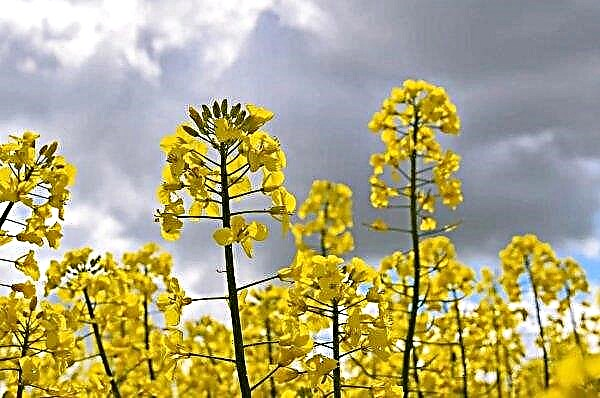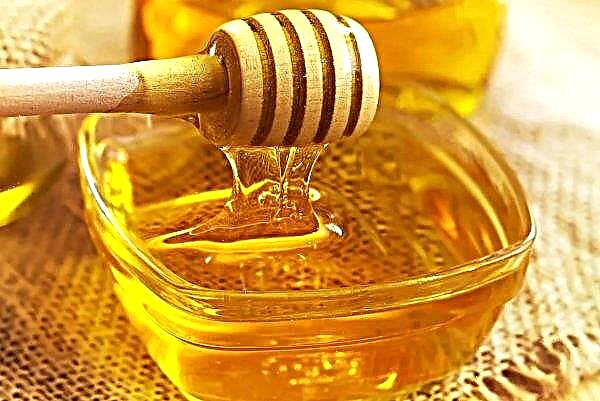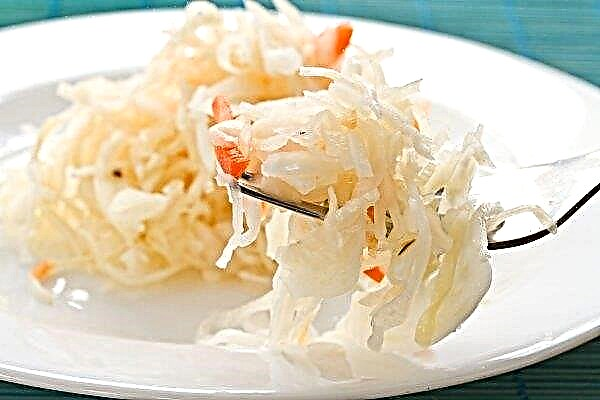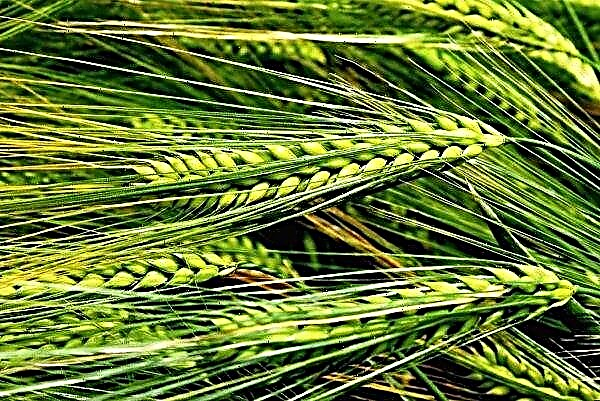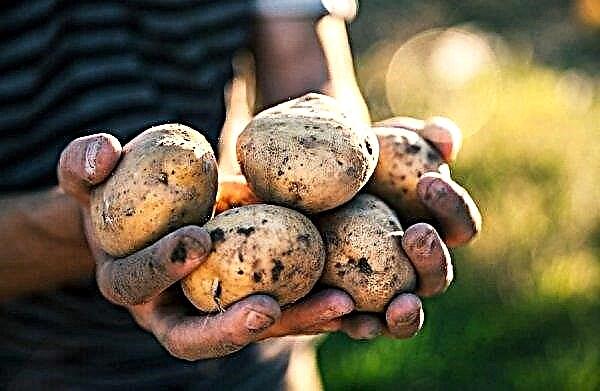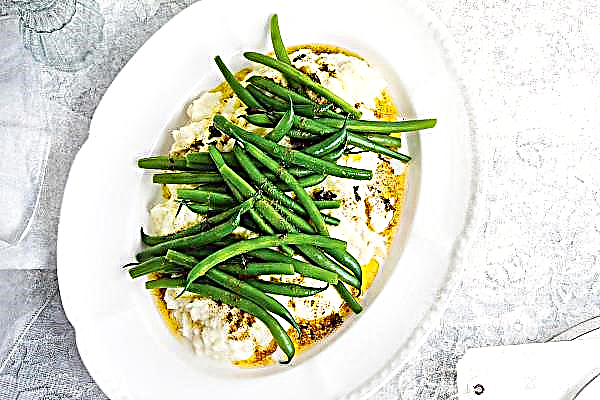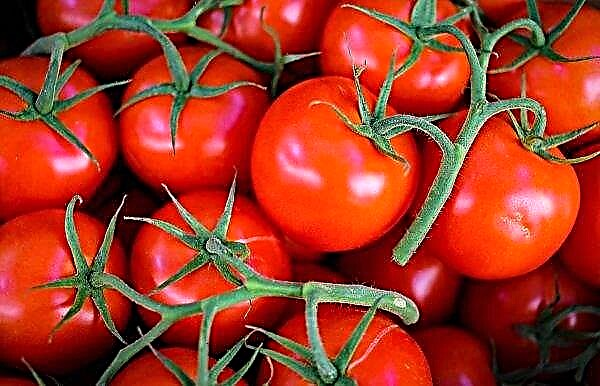Cacti attract the attention of many gardeners. They are valued for their unusual appearance and unpretentiousness in care. How hymnocalicium is bred - a plant from the Cactus family - will be discussed in this review.
Houseplant Description
Cactus hymnocalicium is considered to be of the same genus of succulent plants. His homeland is South America. In the wild, a flower grows in groups or alone. It is quite common in mountainous areas, it can grow at an altitude of 1000 m above sea level.
Representatives of the genus form a fleshy flattened stalk in the form of a ball 4–15 cm across and 2–8 cm high. It has about 20 ribs, many humps and closely spaced, branched spines 1.5–3.5 cm long The stem is painted green with a touch of gray or brown. Varieties with red and yellow stems are also bred. Such succulents are usually grafted on green cacti, forming a mix.
Did you know? The fact that cacti protect the body from radiation coming from a computer monitor is a myth. There is not a single scientific study that would confirm such a unique effect of the plant.
Starting from the age of 2-3, the succulent plant produces bare buds and white, gray, yellow, red flowers, shaped like funnels. In diameter, depending on the species and variety, they reach 3–10 cm. Usually, flowers are located at the apex. Flowering lasts a long time - from April to November. Flowers bloom slowly - in the blossomed state can stay up to 10 days. After flowering, oval-shaped fruits of gray-green color with a diameter of 2 cm and a length of 4 cm appear. According to data from various sources, the number of species of hymnocalycium is from 50 to 80. Among flower growers, you can find simpler names for this plant - “holocaechen”, “naked a cup".
In room conditions, such varieties are grown:
Conditions of detention
Since the hymnocalycium is a native of warm countries, at home it is necessary to create a certain microclimate for it: a warm room, where there is a lot of sunlight. The recommended temperature of the plant is + 20 ° C – 24 ° C. Since October, to comfortably transfer the plant to a dormant state, the temperature is gradually reduced to + 15 ° C – 18 ° C. Succulents can actively grow at +5. Moisture prefers low humidity - up to 50%.
Important! The soil purchased in the store does not require pre-treatment before planting. It is necessary to disinfect the cooked one yourself - calcine in the oven or pour with a solution of potassium permanganate.
Despite the fact that he needs good lighting, growing on a windowsill will require shading from direct sunlight. In winter, additional lighting is needed. Best of all, the flower will feel in a light, loose soil substrate, unsaturated with organic elements. It can be a mixture of clay soil, sand, peat, charcoal, expanded clay. The optimum level of acidity is 5–6 pH. Suitable purchased substrate designed for cacti.
Home Care
Gimnokalitsium - unpretentious plant. But stable growth, flowering and maximum decorativeness can be achieved by adhering to care recommendations. As a rule, among the tips on how to care for the hymnocalycium are stable procedures: watering, top dressing, transplantation.
Location selection
For growing succulents, a well-lit window sill is suitable. It is advisable in the future not to move the flower to another place. In the summer, it can be transferred to fresh air - a balcony or a loggia. The choice of pot will depend on the variety grown. Most representatives of the genus Gimnocalycium require a shallow flower pot - a little larger in size than the root system.
Watering and fertilizer
There are no special watering requirements for a cactus. It is watered in the same way as most indoor crops - as the top soil layer dries up. To moisten the soil, use at least 2 days of standing, filtered or rainwater at room temperature. Hard water from the tap should not be watered, this can trigger the development of fungal diseases.
In winter, watering is limited to a minimum. The reduction is carried out gradually. Starting in March, they are also gradually returning to the normal irrigation regime. Spraying and water procedures, even on hot days, are not required for the cactus.
Important! It is necessary to ensure that the watering of the succulent is moderate. With excessive waterlogging, the root can rot and separate from the stem.
For good growth and development of the hymnocalycium, fertilizer is required. The flower is fed from May to August. The frequency of top dressing is 1 time in 14-21 days. Ready-made fertilizers designed specifically for cactus plants are purchased for this procedure. Application is made according to the standards specified in the attached instructions. In the dormant period - from October to March - any feeding is prohibited. This will negatively affect the development of the plant and its ability to accumulate nutrients during the dormant period.
Transplant Features
It is necessary to transplant a flower in the spring. Young plants are subject to annual transplantation into more spacious containers. Mature cacti are transplanted as needed. To transplant the plant, prepare a larger container and substrate. Succulents are abundantly watered so that an earthen lump easily leaves the pot. Then they extract it, clean the roots and examine them for affected areas.
If necessary, the roots are trimmed and treated with charcoal. A layer of drainage is poured into the bottom of the new pot. Then a layer of soil is poured. Succulents are set in the center of the pot, evenly spreading the roots. Sprinkled with earth. After planting in a pot carry out abundant watering.
Did you know? Gymnocalycium is advised to grow people who find it difficult to restrain anger and irritation. It is believed that succulent absorbs negative emotions.
Vaccinations
To get beautiful colorful mixes, chlorophyll-free succulents can be grafted. For the stock, the trihedral hylocereus is most often taken, as well as eriocereus or trichocereus. For ordinary forms, vaccination will be required only in case of a serious illness or condition of the plant on the verge of death.
The vaccination technology is as follows:
- Use a sharp, sanitized knife to cut the scion and stock.
- Join slices.
- Put on an elastic band or dressing.
- To sustain a week.
- Remove the bandage.
Video: technology for performing vaccinations of the hymnocalicium
Breeding methods
Gymnocalycium propagates in 2 ways:
- Seed.
- Side layering.
Seeds
Planting seeds is difficult and time-consuming. Not all flower growers are successful in this procedure. But plants grown from seeds are distinguished by endurance and rapid growth. This procedure can be done at any time of the year. Buy a substrate intended for cacti. It is moistened and then seeds are placed to a shallow depth. Over the course of a day, the substrate is periodically sprayed from the spray gun with warm, settled water to prevent it from drying out. You can organize a mini-greenhouse. A container with seedlings is exposed in a warm sunny place. The temperature for germination should be at + 20 ° C. After a year, succulents grown from seeds can be planted in separate containers.
Over the course of a day, the substrate is periodically sprayed from the spray gun with warm, settled water to prevent it from drying out. You can organize a mini-greenhouse. A container with seedlings is exposed in a warm sunny place. The temperature for germination should be at + 20 ° C. After a year, succulents grown from seeds can be planted in separate containers.
Important! Work with chemicals at home should be done in a well-ventilated area with protected hands and face. It is forbidden to drink, eat or smoke during treatments.
Side layering
After the formation of side layers, they are carefully separated. Then for 24 hours they are taken to a room with low humidity for drying. Now the cuttings are planted in a moist substrate for rooting, and after the appearance of the roots - in a small container. Since rooting in succulents is usually fast, planting immediately in a pot is possible. If the layering has roots, then reproduction is best done simultaneously with the transplantation of the mother plant.
Video: propagation of the hymnocalicium by side layers
Pest and Disease Control
If the flower is not properly looked after, it may be susceptible to attack by various diseases or harmful insects. Of the diseases most often called stem and root rot. The first is manifested by the formation of softened brown spots on the lower part of the stem. They must be removed and treated with the “Carbendazim” preparation. The other, root, can be suspected if the flower has stopped growing and has not released buds, or noticed during transplantation.
Sick roots need to be trimmed, healthy ones should be washed with hot water, the places of cuts should be treated with activated charcoal, fungicide, allowed for indoor plants. Then the roots are dried during the day and transplanted into a new pot with new soil.
Of the parasites on the succulents can settle:
The mealybug leaves a characteristic symptom - white loose discharge, similar to cotton wool. They fight it with soap wipes, sprinkles with a solution of green soap, infusions of tobacco, garlic, a decoction of cyclamen, tincture of calendula, alcohol, drugs “Aktara”, “Biotlin”, “Calypso”, “Confidor”, “Fitoverm”.
The presence of a web on spines and stems, as well as small red dots, will tell you that the plant was chosen by a tick. This parasite loves heat and dryness. To get rid of it, you need to wipe the plant with a soapy solution. In case of severe infection, treatment is needed funds Fitoverm, Bi-58, Karate, Iskra-M, Actellik.
The shield is easy to spot. This is a small insect covered with a hard shell. It feeds on the flower juices. The first symptoms of the appearance of the scale are sticky fluid on the trunk. Destroy it mechanically - scraping with a brush. Acetic wipes are also effective, rubbing with tincture of garlic, red pepper. With severe infection, they resort to chemical treatment using “Fitoverm”, “Actellik”, “Metaphos”.
In addition to diseases and pests, when growing a plant, there are other problems:
- Stunting. Reasons: insufficient watering in the summer and excessive - in the winter. The recommended mode of moisturizing should be established.
- The bottom of the stalk wrinkled. It is observed with waterlogging. Watering needs to be reduced.
- Hard spots on the stem. There may be several reasons: pest damage, exposure to cold temperatures, mechanical damage. It is necessary to establish the cause and eliminate it.
- Stretching the stem. Occurs at high temperatures in winter and lack of lighting in summer. To fix the problem, you need to move the flower pot to a suitable place with the recommended parameters.
 So, the hymnocalicium is an interesting decorative plant in appearance, the care of which is so simple that even beginners in flower business can do it. Succulent is suitable for growing indoors, greenhouses and conservatories.
So, the hymnocalicium is an interesting decorative plant in appearance, the care of which is so simple that even beginners in flower business can do it. Succulent is suitable for growing indoors, greenhouses and conservatories.

